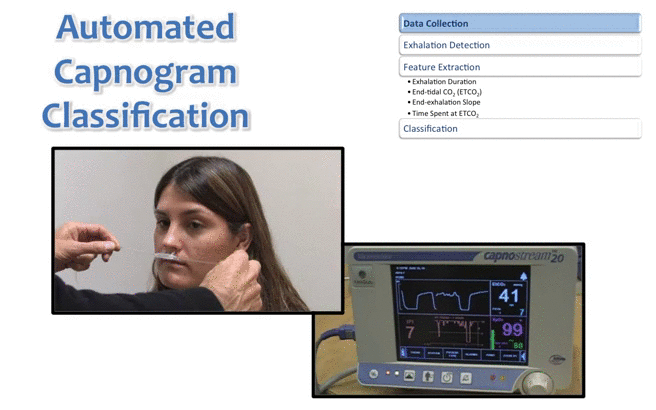Mieloszyk, R.J. ; Verghese, G.C. ; Deitch, K. ; Cooney, B. ; Khalid, A. ; Mirre-González, M.A. ; Heldt, T. ; Krauss, B.S., Massachusetts Institute of Technology, Volume 61, Issue 12, Page(s): 2882 – 2890

Capnography, the measurement over time of the partial pressure of carbon dioxide in exhaled breath, is available in every ambulance service and hospital in the United States and Canada. This non-invasive portable monitoring modality is currently used to confirm endotracheal intubation, as well as to estimate respiratory rate and the carbon dioxide level at the end of exhalation. These current uses of capnography do not fully exploit the information available in the shape of the recorded waveform, or capnogram. We develop a framework and automated tools for quantitative analysis of the capnogram. Rather than relying on visual observation or extracting only a single value from the capnogram, we computationally characterize the morphology of the capnogram through a small number of physiologically based features. These features are incorporated in ensemble-based classifiers that perform well in diagnostic and screening applications.
Chronic obstructive pulmonary disease (COPD) and congestive heart failure (CHF) are common cardiopulmonary pathologies affecting the elderly population. These two diseases often present with similar symptoms, but their treatments are different. The accurate diagnosis can be difficult to obtain in the ambulance and can take time even in the hospital setting. Our classifier facilitates non-invasive point-of-care COPD/CHF diagnosis. A similarly derived classifier allows COPD/normal screening, which can be helpful in primary care and pre-operative settings. We require as few as 30 exhalations to obtain a classification with computations that can be performed in real time. Our results demonstrate how a more detailed quantitative analysis of data from an existing and ubiquitous instrument can potentially improve patient care.
Related article at MIT News here:
http://newsoffice.mit.edu/2014/algorithm-analyzes-carbon-dioxide-in-breath-1106
Keywords: capnography, classification, ensemble learning, chronic obstructive pulmonary disease (COPD), congestive heart failure (CHF)

